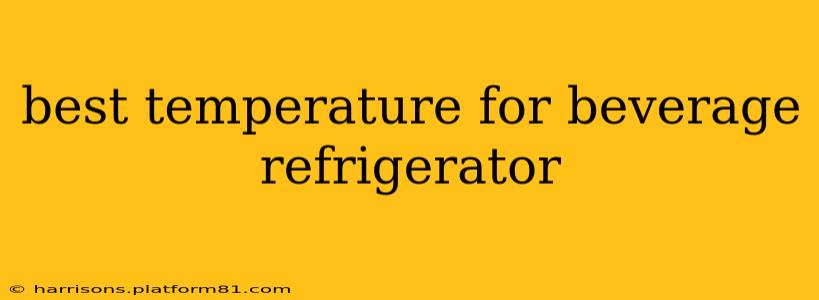Maintaining the perfect temperature in your beverage refrigerator is crucial for preserving the quality and taste of your drinks. Whether you're storing fine wines, craft beers, or simply your favorite sodas, understanding the ideal temperature range will ensure your beverages are always at their best. This guide will explore the optimal temperature settings, factors influencing temperature choice, and troubleshooting tips to keep your drinks perfectly chilled.
What is the ideal temperature for a beverage refrigerator?
The ideal temperature for a beverage refrigerator depends largely on the type of beverage you're storing. However, a general guideline is to maintain a temperature between 35°F and 40°F (1.7°C and 4.4°C). This range is cool enough to keep most drinks refreshingly chilled without freezing them.
What temperature should I keep beer at in a refrigerator?
For beer, a temperature range of 38°F to 40°F (3.3°C to 4.4°C) is generally recommended. Lighter beers, such as lagers, often taste best at the slightly cooler end of this range, while darker, more robust beers might benefit from being slightly warmer. Experiment to find your preference.
What temperature should I keep wine at in a refrigerator?
Wine storage temperatures are more nuanced and depend on the type of wine. Red wines are typically best served slightly warmer, around 55°F to 65°F (13°C to 18°C), while white wines and sparkling wines are better served much cooler, between 45°F and 55°F (7°C and 13°C). A dedicated wine refrigerator with separate temperature zones can be invaluable for optimal wine preservation.
What is the best temperature for soda in a refrigerator?
For sodas and other carbonated beverages, maintaining the temperature between 35°F and 40°F (1.7°C and 4.4°C) is generally ideal. This helps to preserve the carbonation and maintain the refreshing fizz.
Factors Affecting Beverage Refrigerator Temperature
Several factors can influence the ideal temperature setting for your beverage refrigerator:
Ambient Room Temperature:
The temperature of the room where your refrigerator is located will affect its internal temperature. If your room is warmer, your refrigerator may need to work harder to maintain the set temperature, and you might consider a slightly cooler setting.
Refrigerator Type:
Different beverage refrigerators have different cooling capacities and temperature control mechanisms. Some are more precise than others. Always consult your refrigerator's manual for specific recommendations.
Beverage Type & Storage Time:
As mentioned earlier, the type of beverage greatly impacts the ideal storage temperature. Additionally, the length of time you plan to store a beverage might influence your temperature choice. Longer storage times generally benefit from slightly cooler temperatures, especially for preserving freshness and preventing spoilage.
Troubleshooting Temperature Issues in Your Beverage Refrigerator
If your beverage refrigerator isn't maintaining the desired temperature, here are a few troubleshooting steps:
- Check the door seals: Ensure the seals around the door are clean and airtight to prevent cold air from escaping.
- Inspect the condenser coils: Dusty or dirty coils can reduce cooling efficiency. Clean them regularly.
- Review the refrigerator's manual: Consult the manual for troubleshooting guidance and recommended temperature settings for your specific model.
- Consider professional service: If the problem persists, contacting a qualified appliance repair technician is recommended.
By understanding the ideal temperature ranges for different beverages and considering the factors that can influence temperature, you can ensure that your beverage refrigerator provides optimal chilling and preservation for your favorite drinks. Maintaining the correct temperature is key to ensuring the best taste and quality of your drinks. Remember to always refer to your appliance’s manual for specific instructions and recommendations.
